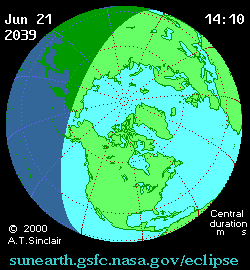Nature Annular Magnitude 0.9454 Max. width of band 365 km (227 mi) Start date June 21, 2039 | Gamma 0.8312 Duration 245 sec (4 m 5 s) Greatest eclipse 17:12:54 | |
 | ||
An annular solar eclipse will occur on June 21, 2039. A solar eclipse occurs when the Moon passes between Earth and the Sun, thereby totally or partly obscuring the image of the Sun for a viewer on Earth. An annular solar eclipse occurs when the Moon's apparent diameter is smaller than the Sun's, blocking most of the Sun's light and causing the Sun to look like an annulus (ring). An annular eclipse appears as a partial eclipse over a region of the Earth thousands of kilometres wide. This eclipse will start only a few hours after the northern solstice and most of the path will go across areas with midnight sun. For mainland Norway and Sweden it will be the first central solar eclipse since June 1954.
Contents
Images
Animated path
Solar eclipses of 2036-2039
Each member in a semester series of solar eclipses repeats approximately every 177 days and 4 hours (a semester) at alternating nodes of the Moon's orbit.
Note: Partial lunar eclipses on February 27, 2036 and August 21, 2036 occur on the previod lunar year eclipse set.
Metonic series
The metonic series repeats eclipses every 19 years (6939.69 days), lasting about 5 cycles. Eclipses occur in nearly the same calendar date. In addition the octon subseries repeats 1/5 of that or every 3.8 years (1387.94 days).
